Up and away: Detailing the 2010 Giro d'Italia's mountains
From Bratello to Tonale: A look at the overall challenges




















The route of this year's Giro d'Italia has been celebrated as a return to the traditional suffer-fest for which the Italian Grand Tour is renowned. A superb final week of climbing in the Dolomites takes riders over iconic ascents of the sport.
There was muffled noise about last year's edition suiting the returned global brand that is Lance Armstrong, with a time trial-heavy route and a lack of the severe pure climbers' terrain that characterises the event.
Fear not, intrepid Giro fans, the tall peaks and days of agony are back at this year's edition, sans Armstrong and with a cast that includes Cadel Evans, Carlos Sastre, Ivan Basso and Gilberto Simoni - all great climbers and capable of putting on a good show in the high mountains.
Stage 6: Passo del Bratello
This isn't an overly difficult climb, which explains why it comes in the first week of racing and it appears in the middle of the 166km journey from Fidenza to Marina di Carrara.
There's only 717m of vertical gain and at 19.5km long, the average gradient is 3.7 percent. Hardly high alps stuff but it's an interesting little climb near the border of the Toscana and Emilia Romagna regions, so it's guaranteed to be picturesque.
Stage 8: Monte Terminillo
Get The Leadout Newsletter
The latest race content, interviews, features, reviews and expert buying guides, direct to your inbox!
For the general classification guys the Giro begins here. A summit finish on a solid climb at the end of the first week of racing means a couple of hopefuls could get caught out if they're not attentive.
At 1,672m, it's one of the highlights of the Abruzzese Apennines but in this year's Giro it's an appetiser for what lies ahead in the final week of racing. Nevertheless, an average gradient of 7.3 percent and distance of 16.1km mean it's nothing to be taken too lightly.
Evidence of this is the fact that Gino Bartali and Luis Herrera have both won on this peak, in 1937 and 1992 respectively. The former grabbed his first maglia rosa of the 1937 edition there and never ceded the race lead en route to overall victory whilst in '92 the Colombian climber took Terminillo and managed eighth overall when the race finished in Milan 12 days later.
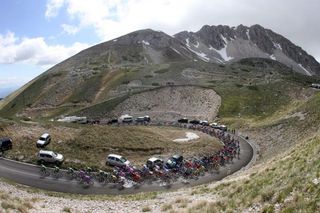
Stage 14: Monte Grappa
Battles were waged around Monte Grappa's peaks during World War I and come May 22 a new chapter in that history will be written as the Giro takes on this favourite of the Veneto region for only the fourth time in the event's history.
Used in the 1968, 1974 and 1982 editions of the Giro (the stages of which were won by Emilio Casalini, Eddy Merckx and Vicente Belda respectively), Monte Grappa can be attacked from nine directions, the easiest being from Romano d'Ezellino... perish the thought, this is the Giro! Therefore riders will approach the 19.2km climb from Semonzo, which makes the average gradient a shade over eight percent with a maximum of 15 percent.
It's lung-busting stuff on what is apparently the 13th hardest climb in Italy.
Stage 15: Monte Zoncolan
In a word: ouch.
And why does this beast of a climb possess such a reputation? The numbers tell the story: riding from Ovaro (which the peloton will do at this year's Giro), there's a 1,210m elevation rise in just 10.5km. After 3.5km the road kicks up brutally to a gradient of around 20 percent and this is where Simoni comes into his own.
There's no respite to the tough slopes and that's the essence of the Zoncolan - pure climbers excel here because there's no room at the front for anyone other than a mountain goat.
Simoni undoubtedly fits that bill - this is his territory. The veteran Italian has the record on this climb, sealing the deal on his 2003 Giro d'Italia title here and winning the 17th stage of the 2007 Giro that ended on this fabled peak. Simoni has finished in the top 10 overall by race's end in every edition this past decade, with the exception of the 2002 and '09 events.
Could he use his experience and nous on the Zoncolan to add another top 10 in 2010? We'll have to wait and see...
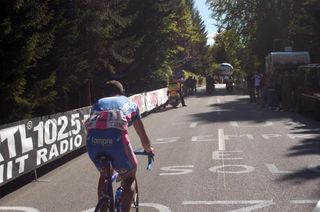
Stage 16: Plan de Corones (ITT)
In a word: ridiculous.
When Angelo Zomegnan included the Plan de Corones in the 2006 Giro d'Italia route for the first time in the race's history, some called him a masochist... teams worried about their equipment choices, the weather and the road surface. The stage was shortened but the climb returned as a time trial in the 2008 edition, in which capacity it will again be ridden in 2010.
It's 12.9km of pain and suffering that gains over 1,000m in elevation with a massive sting in the tail in the form of a 24 percent maximum gradient that comes oh-so-close to the finish. Add the fact that it follows the Monte Zoncolan stage (although there's a rest day in between) and it's plain to see that only the toughest will be in with a shout at victory here.
Franco Pellizotti was the quickest up here in '08 but the Liquigas rider won't have a chance to repeat those heroics this year; Sastre could be a very likely stage victor given his light stature and propensity for gaining strength as a Grand Tour progresses.
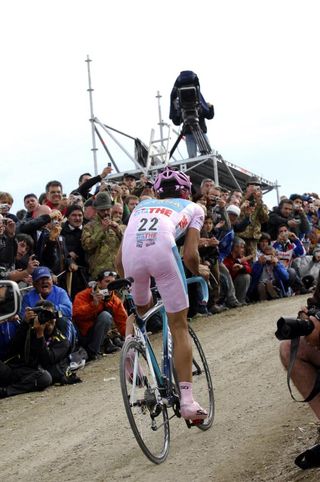
Stage 17: Passo delle Palade (Gampenjoch)
This stage should in theory be a chance for the general classification riders to back off the gas after the Monte Zoncolan/Plan de Corones double, so breakaway contenders will probably have to attack before, or on, the Gampenjoch.
It's nothing too offensive - 18.85km long, with an elevation gain of 1,214m for an average gradient of 6.4 percent and a maximum of nine percent. It's enough for a break to succeed on if the elements of the escape are right.
Stage 19: Passo di Santa Cristina
The Santa Cristina is the softener for the Mortirolo that starts just 20km after the day's second summit. Riders may want to say a couple of prayers to whichever saint they believe in, asking for good legs this day - they're going to need them.
As softeners go, this is a beauty; 11km at 11 percent with a maximum pitch of 14... it's a brave soul who tries his luck on this ascent with the Mortirolo to come. And with a 20km descent after the climb there's every chance an attack will be ill-fated as the big names prepare for the day's main course.
A nice appetiser, nevertheless - buon appetito!
Stage 19: Passo del Mortirolo
It's quite fitting that in 2010 the Mortirolo will be used for the 10th time in the Giro d'Italia. Its slopes have hosted the world's greatest riders, including Marco Pantani, who holds the record of 42 minutes for the ascent.
Watch his ride up the Mortirolo in the 1994 Giro and you'll see a rider at his scintillating best. A trademark vicious acceleration left maglia rosa Evgeni Berzin in his wake and the young Pantani secured his second successive stage victory, having won the previous day's 235km journey from Linz to Merano.
Basso crested this climb first during his victorious 2006 Giro campaign. While much has happened in relation to the Italian since then, he's got what it takes to conquer the Cima Pantani. That year it was Simoni and Basso going mano a mano up the slopes... there's a slim chance we may witness that again this year, depending on both riders' form at the end of a tough race.
And why is it so revered? It rises 250m more in elevation than the Plan de Corones climb whilst covering the same distance on the road - 12.8km. That gives it an average gradient of 10 percent with a maximum of 18 percent. For riders who will be road weary and have the Gavia to ride the next day, that's brutal.
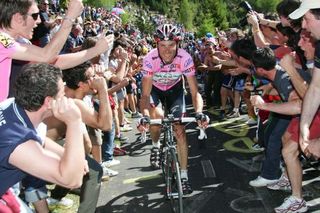
Stage 20: Forcola di Livigno
A quick wave to the Swiss fans and it's time to climb back into Italy on the Forcola di Livigno. It's dwarfed in reputation by the Gavia on the day's parcours but it offers 18km of climbing at an average of seven percent. That's solid and will offer the likes of Sastre the chance to start a run at the front of the field.
Merckx won in Livigno in 1972 whilst Ivan Parra took the honours there in 2005; during last year's race this climb may have been the main highlight of a mountainous stage; in 2010 it's just one of the tasty treats on offer during a day that may decide who enters the final time trial with the maglia rosa on his back.
Stage 20: Passo di Gavia
Mention the Gavia to most English-speaking cycling fans and they'll immediately refer to the exploits of Andy Hampsten on this feared climb in the 1988 Giro. The footage from that 14th stage of the race is epic - riders with hair covered in snow, bodies struggling to function in the shroud of mist and cold. It chills the bones just to watch.
And while the local riders were forced to stop and don jackets and the like, Hampsten recalled taking neoprene gloves and a vest from the 7-Eleven team car, allowing him to maintain his advantage.
"All the riders went shopping that morning at ski shops and bought everything warm and useful they could find: Gortex insulated gloves, wool balaclavas, anything they wanted," recalled Hampsten 20 years later.
"I got a wool hat, a neck warmer and neoprene diving gloves; I had those on the whole way up. It was the only concession I made to the cold other than a very thin, long-sleeved undershirt."
Whilst few remember that Johan van der Velde crested the climb first and Erik Breukink won the stage, the image of Hampsten climbing through the snow remains one of the most poignant in modern cycling history.
The climb itself is an important part of that history, a monster that regardless of climatic conditions is a tough proposition.
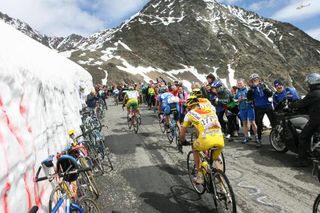
Stage 20: Passo del Tonale
The last real climb of this year's Giro, the Passo del Tonale, will benefit as a spectacle by the fact that the Gavia precedes it in the day's 178km parcours.
It's nothing in comparison to what the riders have already been over on the 20th stage, although they'll have to leave something in reserve for the 5.3 percent average gradient that is spread over 12.1km.
Take a look at our gallery of images from when these climbs were previously used in the Giro d'Italia.
Most Popular

